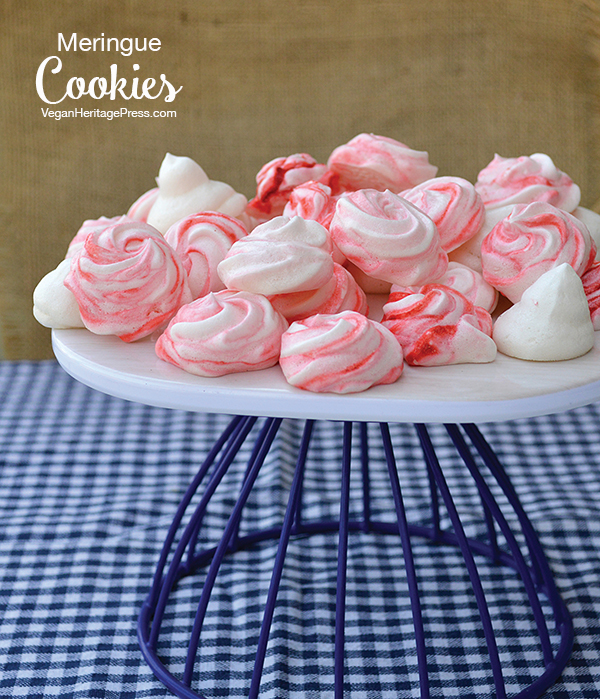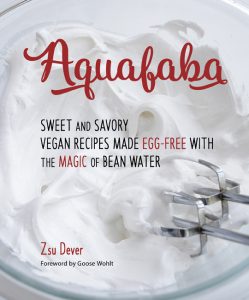 This airy and crisp vegan aquafaba Meringue Cookies recipe from Aquafaba by Zsu Dever is often the first recipe that is made by newbie aquafaba explorers.
This airy and crisp vegan aquafaba Meringue Cookies recipe from Aquafaba by Zsu Dever is often the first recipe that is made by newbie aquafaba explorers.
Aquafaba Meringue Cookies
Makes 20 to 40 cookies, depending on the size of the cookies
Ingredients
- 1/3 cup granulated organic sugar
- 1/2 cup aquafaba (see Note)
- 1/4 teaspoon cream of tartar
Preparation
- If your sugar is not fine granules, grind it for 1 minute in a food processor. Prepare a baking sheet with parchment paper or a silicone mat (the meringue will deflate if baked directly on a baking sheet). Preheat the oven to 195°F.
- Add the aquafaba and cream of tartar to the bowl of a stand mixer. Use a whisk or the balloon whip attachment to hand-whip the aquafaba for 10 seconds. Add the balloon whip to the machine or use a hand mixer to whip the aquafaba for 4 minutes at medium-low speed. Increase the speed to medium-high and continue to whip for 5 to 6 minutes or until the meringue forms firm peaks.
- Continue to whip on medium-high speed and add the sugar, 1 tablespoon at a time, over the course of 1 minute. Continue to beat for another 3 to 4 minutes, or until the meringue forms stiff peaks. Alternatively, you can use a large bowl and a hand mixer.
- Spoon or pipe the meringue onto the prepared baking sheet, about 2 inches apart. Bake the cookies for 1 1/2 hours, turn off the oven, leave the cookies inside the oven, and allow them to cool completely. Once cooled, immediately transfer them to an airtight container. If left out long enough, the cookies will absorb the moisture in the air and become tacky and then dissolve. If your cookies become tacky or begin to absorb moisture, dehydrate again in the oven at 195°F until crisp. You can adjust how crisp you like the cookies by leaving them exposed to the air until they are the texture you like.
Chocolate Meringue Cookies: After the meringue is whipped, sift in 2 teaspoons unsweetened Dutch-process cocoa powder. Fold just to mix most of the cocoa into the meringue, but don’t fold too much or the meringue might deflate.
Swirl-Colored Cookies: To add a swirl to these cookies, prepare the empty piping bag by drawing three or four vertical food-coloring lines inside the bag, using a toothpick or the tip of a butter knife. Draw your lines from down near the tip upward toward the middle of the bag. Use any color of natural food coloring. Once you have prepared the bag, proceed with Step 4.
Note: Although aquafaba is best if homemade using the recipe provided in the book, you can use aquafaba from canned chickpeas. Use the organic, low-sodium, canned chickpeas and strain off the liquid into a measuring cup using a fine mesh strainer. Note the amount of liquid you acquired, then add it to a medium saucepan and bring to a boil. Reduce to a simmer and cook until the liquid reduces by 1/3. Cool the aquafaba completely before using.
 Recipe from Aquafaba, copyright © 2016 by Zsu Dever. Used by permission.
Recipe from Aquafaba, copyright © 2016 by Zsu Dever. Used by permission.
Printable Aquafaba Meringue Cookie recipe:
- ⅓ cup granulated organic sugar
- ½ cup aquafaba (see Note)
- ¼ teaspoon cream of tartar
- If your sugar is not fine granules, grind it for 1 minute in a food processor. Prepare a baking sheet with parchment paper or a silicone mat (the meringue will deflate if baked directly on a baking sheet). Preheat the oven to 195°F.
- Add the aquafaba and cream of tartar to the bowl of a stand mixer. Use a whisk or the balloon whip attachment to hand-whip the aquafaba for 10 seconds. Add the balloon whip to the machine or use a hand mixer to whip the aquafaba for 4 minutes at medium-low speed. Increase the speed to medium-high and continue to whip for 5 to 6 minutes or until the meringue forms firm peaks.
- Continue to whip on medium-high speed and add the sugar, 1 tablespoon at a time, over the course of 1 minute. Continue to beat for another 3 to 4 minutes, or until the meringue forms stiff peaks. Alternatively, you can use a large bowl and a hand mixer.
- Spoon or pipe the meringue onto the prepared baking sheet, about 2 inches apart. Bake the cookies for 1½ hours, turn off the oven, leave the cookies inside the oven, and allow them to cool completely. Once cooled, immediately transfer them to an airtight container. If left out long enough, the cookies will absorb the moisture in the air and become tacky and then dissolve. If your cookies become tacky or begin to absorb moisture, dehydrate again in the oven at 195°F until crisp. You can adjust how crisp you like the cookies by leaving them exposed to the air until they are the texture you like.
Swirl-Colored Cookies: To add a swirl to these cookies, prepare the empty piping bag by drawing three or four vertical food-coloring lines inside the bag, using a toothpick or the tip of a
butter knife. Draw your lines from down near the tip upward toward the middle of the bag. Use any color of natural food coloring. Once you have prepared the bag, proceed with Step 4.
Although aquafaba is best if homemade using the recipe provided in the book, you can use aquafaba from canned chickpeas. Use the organic, low-sodium, canned chickpeas and strain off the liquid into a measuring cup using a fine mesh strainer. Note the amount of liquid you acquired, then add it to a medium saucepan and bring to a boil. Reduce to a simmer and cook until the liquid reduces by ⅓. Cool the aquafaba completely before using.
Recipe from Aquafaba, copyright © 2016 by Zsu Dever. Used by permission.
